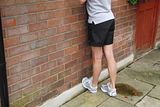Training & advice
Andy Byrne - Shin Pain
Andy Byrne from David Roberts Physiotherapy advises what to do if shins are sore
If you are training for the marathon, you will have just completed a few weeks of high mileage. This means that your legs have been put under the most strain, which means that serious shin injuries can occur, such as stress fractures. For this reason if you are getting shin pain, then you should see your Physiotherapist to check there isn't any serious injury.
Hopefully, some of you will have read my article on shin and foot care last year, and as such will be aware of the need for regular stretches to the lower leg to avoid tightness in the muscles here, which accounts for a lot of the shin pain that I see. Muscular tightness is the most common cause of non-serious shin pain ie not a stress fracture. This is particularly true at this stage of training when the legs are being asked to carry you further than before, or are being used more regularly. Stretching at this stage is more important than ever.
The best stretch for the front of the shins that I have found is as follows: In bare feet, kneel on the floor (a carpeted one) with your toes pointing out behind you. Slowly sit backwards onto your feet keeping your back straight. Use your hands behind you to support some of your weight so that you feel a stretch in your shins and the tops of your feet, but you are not putting all of your weight through your feet. Hold for the standard 20-30 seconds, and repeat as part of your stretching regime, as well as before and after running. You can vary the stretch slightly by leaning slightly left or right, or by turning the feet slightly in or out as you do the stretches to target the area that feels like it needs the stretch the most.
However, recently I have been seeing a number of people with shin pain who have no obvious tightness in the muscles in the front of the shin. Their problem was tightness in the Soleus muscle. This muscle is in the calf, under Gastrocnemius which is the large calf muscle. Because of how Soleus attaches to the tibia, the shin bone, if it is tight, it can pull on the bone a little and cause inflammation and pain. To stretch this muscle, you do your standard calf stretch, but bend the knee of the leg you are stretching. Hold for the usual 20-30 seconds. Whenever you are doing calf stretches, make sure you alter the angle of stretch slightly. Ie. If you do the standard "pushing the wall down" stretch, then step your front foot forwards for one stretch, then slightly to the left, and then slightly to the right.


An alternative calf stretch..........with bent knee to stretch the Soleus
Apart from stretching, I would recommend Sports Massages, to loosen tight muscles, and warm baths followed by stretching to relax tight muscles. I wouldn't recommend you having a warm bath straight after running however, as any area of inflammation will be worsened by heating the area. You could perhaps have the baths on your rest days to aid recovery.
Only in severe cases, where the above approach has not settled the pain, would I suggest Orthotics at this stage in training. Significantly altering your biomechanics (how you run) with the use of orthotics at this stage in your training, can cause other problems, and as such I would not generally recommend it if it can be avoided.
The basic stretches and advice in the article should help ease the problem, but as mentioned in the knee pain article, a full assessment of the cause of the problem is needed, and rehabilitation after the Marathon is required to ensure the problem does not keep occurring
